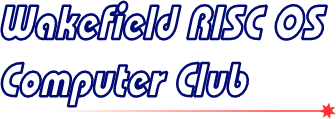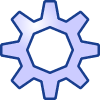Meeting: “How I Use My Computer...”
A trio of WROCC members talked about how they use RISC OS. Derek Baron described some of the software and other resources he had created for teaching chemistry, while Colin Sutton talked about creating panoramic photographs and showed us some sequences of pictures that he had taken at the April show and 25th Anniversary meeting. Steve Potts closed the evening by looking at some of the new features that come with RISC OS 6.
Report by Steve Fryatt
Following on from recent successes, November’s meeting was another in-house production with three members giving short presentations about subjects they are interested in. The evening started with Derek Baron taking a look at the way he used his computers; he was followed by Colin Sutton, who showed off some of his digital photography; finally, Steve Potts closed things off by demonstrating some of the features of RISC OS Six.
Chemistry with the Beeb
Back in the eighties, Derek Baron was a chemistry teacher in a Leeds secondary school. On being introduced to the BBC Micro, he quickly realized the possibilities of the new machine and – having discovered that much of the early software left something to be desired – started to write his own educational tools.
Most of his early work was teaching aids intended for use by pupils. Subjects included demonstrations of processes such as chromatography, interactive examples of techniques such as equation balancing, and practical tests of activities such as the identification of substances based on their chemical reactions.
As was common in those days, the software was written to take advantage of Mode 7 – a configuration which did not work well with our projector. Although Derek was able to demonstrate the software, some nifty camera-work was required from Peter Richmond to relay the images shown on the monitor to the audience via the projector.
With the arrival of the Archimedes, Derek quickly made use of the vastly improved graphics capabilities. One of his early efforts was a 3D wire-frame object viewer for the design and technology department, which he used to show us the construction of some woodwork joints. It wasn’t long, however, before he came back to chemistry.
The 3D viewer evolved into a system for displaying the molecular structure of chemical substances; over the years, Derek has added to the library of structures, and he showed us some of the vast collection. The program generated a pseudo-3D effect with the aid of two slightly different images shown side by side: by defocusing the eyes slightly, some people were able to achieve a better effect of depth.
Not content with simple stereograms, Derek also experimented with the creation of autostereograms: those collections of apparently random dots which hide a 3D shape within. Having created a utility to convert sprites into these ‘magic eye’ pictures, he produced a range of examples which he handed around the audience.
Finally, Derek mentioned his use of Impression II for creating worksheets and pamphlets for his students to use. Enlivened with diagrams and illustrations, including molecular stereograms created with his own software, they had proved popular as a learning aid.
Derek’s talk concluded with a run-down of some of the useful hardware and software that he had added to his machine over the years: extra memory, network cards, Uniprint and so on. Tantalizingly, he hinted that this may only have been ‘part one’ – we might be able to look forward to a sequel on the present-day uses for his RiscPC.
Panoramas and more
Derek was followed by Colin Sutton, who opened his part of the evening with an audio-visual sequence of photographs taken at the club’s 25th Anniversary back in April. The pictures showed a selection of the people and hardware present on the night, including – poignantly – Andrew Bryden collecting his life membership from Mike Cook.
When the sequence finished, Colin moved on to discuss panoramas – a subject that he has looked at in recent issues of this newsletter. He started by showing us a ‘simple’ mile-wide view of Shipley, the Aire valley, Baildon and Ilkley Moor taken from above Bradford, before moving on to a vertical panorama of Bradford’s Cartwright Hall. Made from four 10 megapixel images, this contained almost 40 megapixels of detail – enough to clearly show the Yorkshire stone blocks used in the building’s construction.
The third set of panoramas were of the Sing Bradford choir event, and three separate images showed the participants with no-one missing, cut in half or duplicated. Colin said that all the images had been taken without the aid of a tripod. Care had to be taken with the lens used and the focusing to ensure that verticals remained vertical and undistorted, but otherwise the same rule applied as for other panoramic shots: leave plenty of overlap between the images.
Colin closed his part of the evening by showing us a second audio-visual sequence containing images of this year’s Wakefield Show. The images ran through the day, from arrival at the venue to clearing up at the end, complete with titling and effects, and he wondered if they could be used to promote the club or RISC OS in some way.
A look at RISC OS Six
The evening was closed by Steve Potts, who had another go at demonstrating RISC OS Six after hardware problems with his laptop had thwarted his last attempt. The new OS has now been installed on the club’s RisCube, and Steve used this machine for the demo.
Most of the new features in RISC OS Six seem to centre on the filer, and this was where Steve began. Keyboard navigation – which has been present on other systems for many years – has finally been added as standard. Not only are there keyboard shortcuts for menu actions (like those of David Thomas’ QFiler patch), but it is also possible to navigate between folders, select objects and run files without using the mouse.
The menu structure (and in particular the Display sub-menu) has been rationalized, and a number of new display and sort options have been added. One which looks useful is the ability to swap rows and columns in the display: coupled with full-info mode, it makes multi-column layouts a lot more readable.
The pinboard has also seen some improvements, including more integration of the old TinyDirs utility. Originally introduced in RISC OS 2, it became part of the RISC OS 3 pinboard but was well hidden. Now files and directories can be dropped onto the iconbar for quicker access using a graphical interface – although some of the features that Steve demonstrated here may have been in later versions of RISC OS 4 as well.
Other areas of improvement mentioned by Steve included Alarm and the support for 8MB of VRAM on Virtual Acorn systems. Although short, the demo did show that development of RISC OS Six hadn’t completely stood still during its long hiatus.







